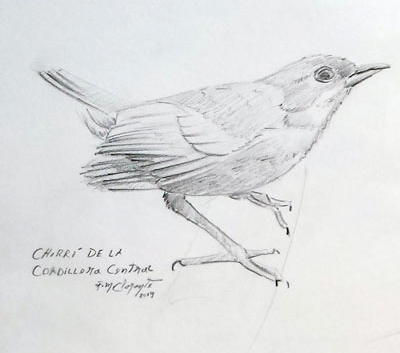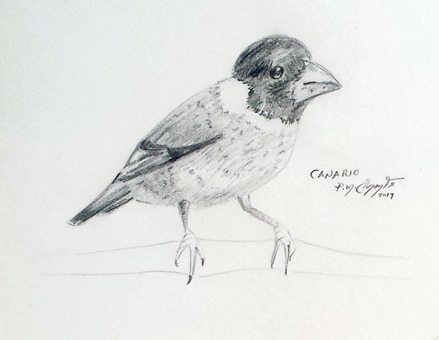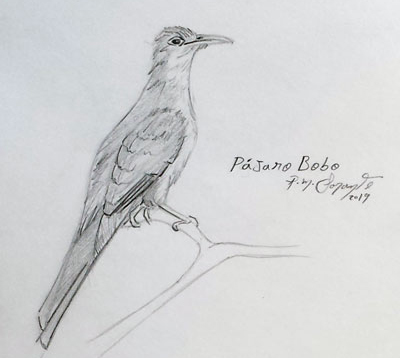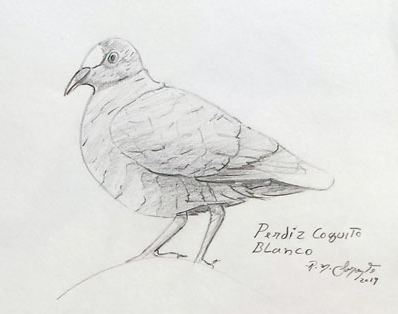Conclusion to the endemic birds drawing of La Hispaniola Island. This section shows the details of each of the species along with a descriptive text explaining their forms and characteristics.

Zumbador Esmeralda
It measures approx. 10 cms in length. Its color is a dark green with a very peculiar natural tan. Inhabits the humid forests of the mountains and mountain where flowers proliferate. It can be seen in the Sierra de Neiba, Sierra de Baoruco, Cordillera Central, the Northern Cordillera and the Haitises National Park. It usually nests in trees and shrubs of low growth.
https://www.diariolibre.com/actualidad/el-primer-zumbido-ICDL398264

Zorzal de la Selle
Its a 25 cm long bird with an intense black color and white spots. Its lower part consist of a reddish hue and has a bright orange beak. At first, it was only known in the Sierra de la Selle, Haiti (hence its name), then specimens were found in the Sierra de Bahoruco and the Sierra de Neiba.

Maroita
It is a very hospitable bird with humans. It distinguishes by its olive green color at the top, which provides a camouflage to pass unattended in the forest. It is an abundant bird throughout the island. It usually nests in low-lying forest areas and puts up to four eggs.

Lechuza cara ceniza
It is a nocturnal animal (like the others of its same family). It measures between 30 and 40 cm in length and shows grayish and dark brown colors. Inhabits the caves and enclosed spaces abandoned on the island. It doesn´t build a nest where to lay its eggs. Its food consists of rodents and other birds of very small size.

Cuervo Palmero (Cao)
It is a bright black bird. It measures 43 cms in length. Inhabits all types of climates and commonly feeds on seeds and eggs of other birds. It emits a loud sound to communicate and lives in flocks. Nest on top of the trees laying 3-5 eggs.

Cuatro Ojos
This bird usually adapts to all climates anywhere, from villages to the most remote fields. It is characterized by its lustrous black head and the white spots that line the eyes. The rest of its body is made up of white, gray and olive green colors on its upper part. It feeds on insects and fruits. Nest in any natural or artificial place and lay 2-3 eggs.

Cigua Cola Verde
It inhabits commonly in mountainous areas, but it can also be found in low zones and near the sea. It is olive green in its upper part and the head and the rest of the body present a light gray color. It feeds on insects and nests in shrubs of short stature.

Cigua Canaria
This bird is composed of very intense colors of glossy black and yellow spots. It is wonderful to see it fly in flocks in a clear sky in the middle of spring. Inhabits any environment and feeds on fruits and insects.

Cigua Amarilla
It is one of the most beautiful birds for its variety of colors. It is characterized by having a black head with thick white lines above and below the eyes. Its front part is yellow with an orange tone at the top and its wings are black with layers of white. Its habitat is found in the middle and high areas of the mountains where it feeds on fruits and insects.

Torico
It is a very small bird that measures between 15-20 cm in length. Usually perches on the tree branch horizontally. Due to this and because it has gray and brown colors with white spots, it is easily confused with the bark of the tree where they usually perch. Among its characteristics are having a very small beak and bristles next to it that serve to hunt in full flight.

Chirrí de la Cordillera Central
It is a very shy bird to human contact and rarely can be accessed for observation. Inhabits high mountain areas and the riverside. It is dark brown in its upper part and pale gray in the belly. It feeds on worms and insects.

Carpintero
This bird has the peculiarity of hole in palms and coconut trees looking for insects and also to make their nests. It has the wings and the upper part of its body of a black color with yellow streaks. Its neck is long with black and white spots and from the nape to the crown of the head is red in the case of males (females have the crown black). With its strong claws it can be held upright and uses its strong beak to hammer into the bark.

Carpintero de Sierra
This species lives high in the trees and feeds on insects. It is very elusive and due to its colors, similar to those of the branches on which they perch, it becomes difficult to study them. The upper part of his body is greenish brown, yellow and red in the crown and his chest and belly is white with black spots.

Canario
It is a bird that flies in flocks. Its habitat is of cold mountain climate and usually prefers pine trees to nest. Its head is black, its olive upper part, belly and sides of the neck are yellow. Its tail is yellow with black feathers. It feeds on fruits and seeds.

Papagayo
It is a bird that lives in the mountainous areas of the island. It shows a variety of very striking colors, ranging from a lustrous green in its upper part, turquoise blue in the tail, crimson red in the belly and the wings interspersed between black and white. It usually nests in the hollows of trees carved by itself where it lays up to two light green eggs.

Pájaro Bobo
It is a bird that abounds everywhere. It is beneficial because it help to erradicate the larvae that feed on the leaves of crops. It measures between 40-46 cm in length and has very striking colors ranging from a variety of gray and black to orange and carmine tones. Nest at low high and lay 2-3 eggs.

Perdiz Coquito Blanco
Inhabits deep into the forests and weeds of the mountains, so it is rarely visible. It is clearly distinguished from the other species of its family by its white front. Nest on the ground or in spaces close to the ground and lay 1-2 eggs.

Perico de La Hispaniola
This bird belonging to parrot family differs from others by not being so colorful. Green and red spots predominate above and below the wings. Its tail is usually long and pointed. It feeds on fruits and seeds and walks in flocks of up to more than 100 individuals. Nest in the hollows of trees and lay 2-3 eggs.

Cúa
It is difficult to see this bird because it lives in the top of the tallest trees. Even so, when you have the chance to see up close, you can appreciate its beauty with its distinctive colors. Unlike the Pajaro Bobo, it is characterized by the reddish color in the anterior part that goes from the throat to the chest.

Barrancolí
That´s the name of a bird that nests in the cliffs of mountains and caves. This bird is a bright green at the top and has an elongated beak. Because of its color and its very small size, it is difficult to distinguish in the forest.
This concludes with the list of endemic bird drawings of Hispaniola Island. For descriptive details, I have taken as a reference notes from the book “Birds of the Dominican Republic / Author: Annabelle Stockton De Dod”.

